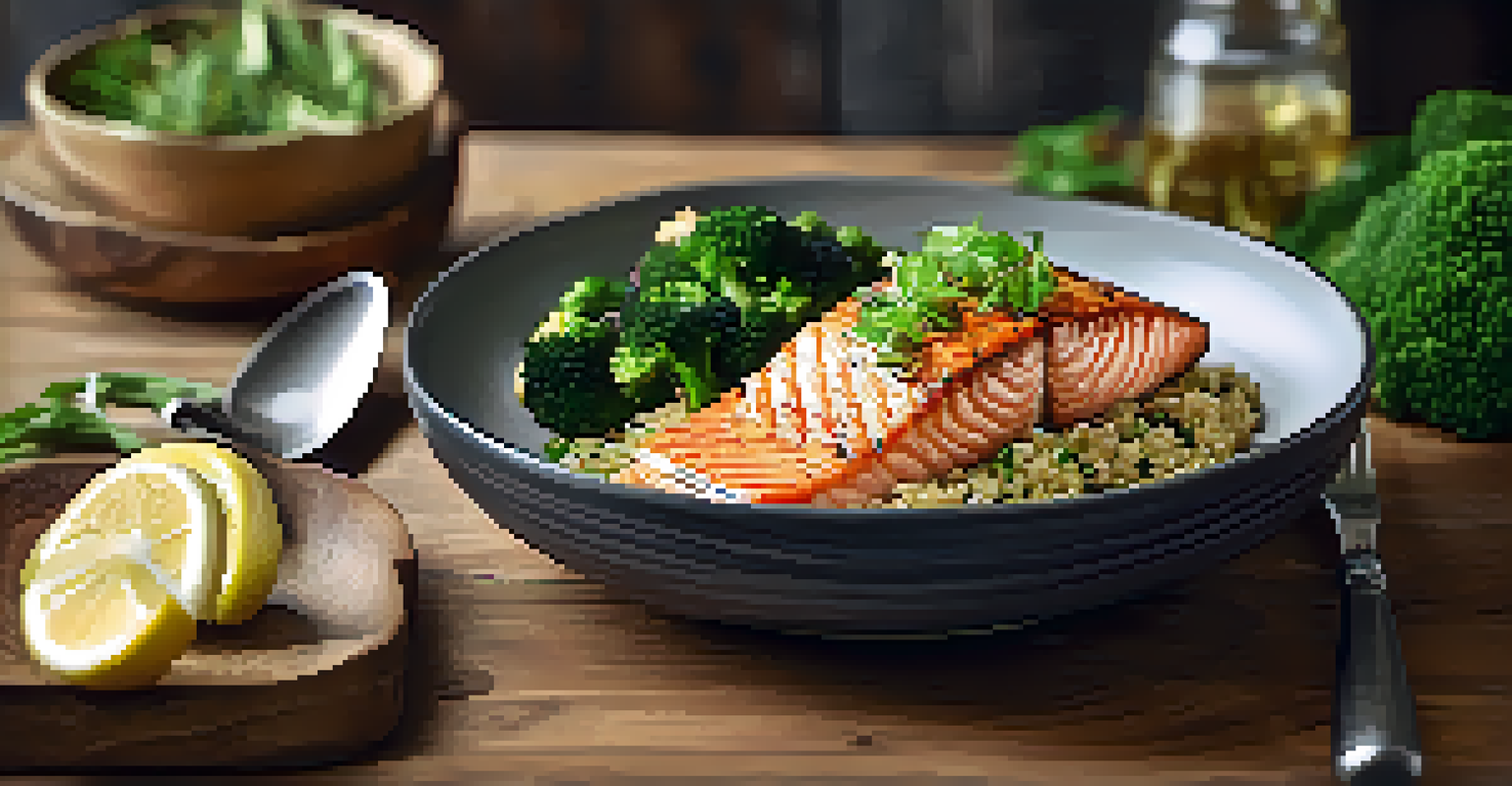Culinary Medicine and Its Role in Preventing Heart Disease

Understanding Culinary Medicine: A Blend of Food and Health
Culinary medicine is an innovative approach that combines the art of cooking with the science of nutrition. It's not just about eating healthy; it's about understanding how the foods we choose can impact our health. Imagine cooking with the intent to heal, where each ingredient serves a purpose beyond flavor.
Let food be thy medicine and medicine be thy food.
This field emphasizes the importance of whole foods, cooking techniques, and meal planning as tools for promoting health and preventing diseases. For instance, using herbs and spices not only enhances the taste but also adds beneficial antioxidants to our meals. It's a holistic approach that encourages us to think about food in a more meaningful way.
By integrating culinary medicine into daily life, individuals can make informed choices that support heart health. This means swapping out processed foods for fresh, nutrient-dense options that can reduce cholesterol and blood pressure, ultimately lowering the risk of heart disease.
The Connection Between Diet and Heart Disease
Heart disease remains one of the leading causes of death worldwide, largely influenced by dietary habits. Diets high in saturated fats, sugars, and sodium can lead to obesity, high blood pressure, and elevated cholesterol levels. Understanding this connection is crucial for making informed food choices that can protect our hearts.

Conversely, a heart-healthy diet packed with fruits, vegetables, whole grains, and lean proteins can work wonders in preventing heart disease. For example, the Mediterranean diet, known for its emphasis on healthy fats from olive oil and nuts, has shown significant benefits in reducing heart disease risk. It’s not just a diet; it’s a lifestyle that encourages mindful eating.
Culinary Medicine Combines Food and Health
This innovative approach emphasizes how cooking and nutrition together can promote health and prevent diseases.
By recognizing the impact of our daily food choices, we can take proactive steps towards heart health. Culinary medicine empowers individuals to become more aware of what they eat, making it easier to incorporate heart-healthy foods into their diets.
Key Ingredients for a Heart-Healthy Diet
When it comes to preventing heart disease, certain ingredients stand out as nutritional powerhouses. Foods rich in omega-3 fatty acids, such as salmon and walnuts, can help lower triglyceride levels and reduce inflammation. Similarly, incorporating fiber-rich foods like beans, lentils, and whole grains can aid in lowering cholesterol levels.
The food you eat can be either the safest and most powerful form of medicine or the slowest form of poison.
Fruits and vegetables, especially those high in antioxidants, play a vital role in heart health. Berries, leafy greens, and citrus fruits provide essential vitamins and minerals that support cardiovascular function. Think of these foods as your heart's best friends, working tirelessly to keep your body in balance.
Spices like turmeric and garlic also offer heart-protective properties, making them excellent additions to your culinary repertoire. By embracing these ingredients, you not only enhance the flavor of your meals but also promote better heart health.
The Role of Cooking Techniques in Heart Health
How we prepare our food can significantly impact its health benefits. Cooking techniques such as steaming, grilling, or baking are preferable to frying, as they help retain nutrients while minimizing unhealthy fats. For example, grilling vegetables can bring out their natural sweetness without the need for excess oil.
Moreover, batch cooking and meal prepping can encourage healthier eating habits. By preparing meals in advance, individuals can avoid the temptation of unhealthy takeout options, ensuring they have nutritious meals on hand. Think of it as setting yourself up for success in the kitchen!
Heart Health Starts with Diet Choices
Understanding the link between diet and heart disease helps individuals make informed choices to protect their heart.
Emphasizing fresh, minimally processed ingredients in your cooking techniques can lead to more heart-healthy meals. This not only supports better health but also fosters a deeper connection to the food we consume.
Mindful Eating: A Key Component of Culinary Medicine
Mindful eating is a practice that encourages individuals to pay attention to their food, savor each bite, and recognize hunger cues. This approach can help reduce overeating and improve digestion, both of which are beneficial for heart health. By being present during meals, we can make better choices about what and how much we eat.
Culinary medicine promotes mindfulness by encouraging individuals to cook at home and experiment with new recipes. This not only enhances cooking skills but also fosters a sense of ownership over one’s diet. Imagine the joy of creating a delicious, heart-healthy meal from scratch!
Incorporating mindfulness into our eating habits can transform mealtime into a more satisfying and healthful experience. It’s about creating a positive relationship with food that prioritizes health and well-being.
Community and Culinary Medicine: Shared Health Benefits
Culinary medicine is not just an individual journey; it can be a communal experience. Cooking classes, community gardens, and shared meal experiences can foster a sense of belonging while promoting heart-healthy eating. Think of it as gathering around the dinner table, sharing not just food but also knowledge and support.
Participating in community initiatives around food can also inspire healthier choices. When people see their neighbors embracing nutritious cooking, it encourages them to join in. This collective approach can create a culture of health that benefits everyone involved.
Mindful Eating Enhances Health Benefits
Practicing mindful eating fosters a positive relationship with food, leading to better health outcomes.
By engaging with others in culinary medicine, we can make heart-healthy living more enjoyable and accessible. Together, we can share recipes, tips, and experiences that contribute to a healthier lifestyle.
Conclusion: Embracing Culinary Medicine for Heart Health
In conclusion, culinary medicine offers a unique and effective approach to preventing heart disease through the power of food. By understanding the connection between what we eat and our heart health, we can make informed decisions that support our well-being. It’s not just about following a diet; it’s about cultivating a lifestyle centered around nourishing foods.
As we embrace cooking techniques, key ingredients, and mindful eating practices, we empower ourselves to take charge of our health. Culinary medicine encourages us to explore new flavors while prioritizing heart health, making the journey enjoyable and rewarding.

Ultimately, by integrating culinary medicine into our lives, we can savor delicious meals while safeguarding our hearts. It’s a delicious path to wellness that we can all embark on together.